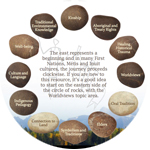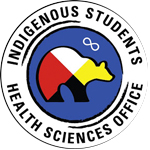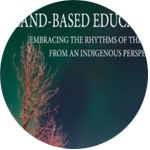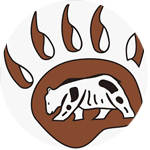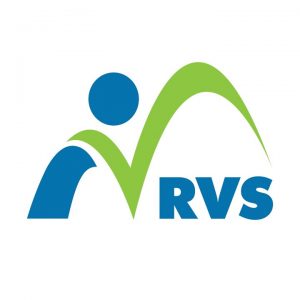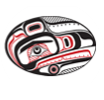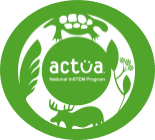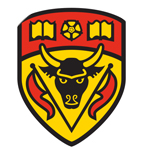Learning from the Land
In this section, you will learn about the importance of learning with the land, led by Indigenous Peoples.
Introduction
Although there is much diversity between First Nations, Métis, and Inuit, a deep and abiding connection to the land is common. Dr. Leroy Littlebear says that “The land is a sacred trust from the Creator. The land is the giver of life like a mother. The ecological aspect of Indigenous knowledge is all about the land. The land is a source of identity for Aboriginal People.”1 Elder Bob Joseph explains that “traditional knowledge, languages, cultural practices and oral traditions built up over the millennia are all connected to the land.”2 Living in balance with the land and each other connects with Indigenous languages.3 Learning from the land interconnects with learning from the natural world ,which survival is dependent upon. Indigenous cultural understandings of the natural world are embedded in language and stories connected to the land, water, air, and fire.
Connection
The values of reciprocity, respect, balance, and connection to spirituality are central to learning from the natural world. Indigenous histories and stories are embedded in the relationship and respect of the natural world. Leaders can partake in and facilitate opportunities for nature-based learning experiences led by Indigenous people who have specific background knowledge in topics such as plant and medicine, ceremony, star stories, sacred fire teachings, traditional governance, rites of passage, spirit and intent of Treaty experts, hunting and gathering, and land based arts. There are many traditional and sacred sites of cultural significance across Alberta, so it is important to work closely with local Indigenous Peoples when engaging in land based learning opportunities. This will help ensure that experiences are respectful, authentic, and meaningful. Learning from the land is often referred to as Place Based Learning (PBL) or Traditional Ecological Knowledge (TEK) and is becoming more commonplace within education systems because it presents an opportunity for educators and students to learn more about the histories and stories of the land, sky and water and people while meeting curricular outcomes.
Traditional/Ancestral Territory
Traditional/Ancestral territory may or may not overlap with Treaty boundaries. For example, the Blackfoot Nation’s ancestral territory once occupied areas up to what is now Edmonton with the North Saskatchewan River being the major landmark that signified the boundary between nations. This territory contrasts with the Treaty 7 boundaries which are landmarked by the Red Deer River. Traditional/Ancestral Land use extends beyond the borders of reserves in which First Nations were forced on to. Prior to the Crown Treaty with First Nations, there were Peace Treaties between First Nations. For example, Wetaskiwin which means “the hills where peace was made” was the site in which the Cree and Blackfoot Nation entered Treaty. This Treaty set forth the mutual agreement that both nations would live in peace, have mutual respect and share the territory. The Métis Nation homeland developed along the fur trade routes of what is now known as Manitoba, Saskatchewan, Alberta, parts of Ontario, British Columbia, Northwest Territories, and the Northern United States.5 Métis and First Nations families have been surviving on these lands for generations prior to the making of Alberta.
The history and teachings of this land, water, and sky runs deeper than the past 500 years. Nations coexisted, survived and utilized the land, water and sky prior to Crown Treaties and colonial takeover. Understanding the historical context of Indigenous relations with each other, the land natural world and newcomers to the land is an important part of reconciliation.
Forced Disconnection
The connection to the natural world has been disrupted through policies of colonization, assimilation, and attempted genocide. Forced disconnection from the land and water has caused spiritual, emotional, physical, and mental damage to many Indigenous Peoples. Some examples of methods used to disconnect Indigenous Peoples from the land include forced relocation, forced confinement onto reserves, fraudulent land acquisition schemes, Métis scrip fraud, ecocide, and banning of traditional food and medicine harvesting. Outlawing ceremonies, which celebrate and honor the natural world, was another method of attempting to disconnect Indigenous Peoples from their cultural way of life in which the natural world is connected to kinship bonds.
Indigenous Peoples have and continue to be impacted by the government of Canada’s aggressive colonial displacement and dispossession tactics while persistently excluding the Metis Nations sovereign rights. 6 An excerpt from the Alberta Metis Nation websites History of Métis Self-Government website explains:
When Canada expanded into the Northwest following confederation, we were here. This is our Homeland. When Canada asserted its sovereignty here, we had a right to be treated as a nation. When Canada took our lands for settlement, we had a right to fair compensation. We got neither. Canada denied our nationhood. When we declared self-government—in 1869, in Red River; in 1885, in Batoche—Canada tried to break us. Canada gave us scrip—certificates that offered a false promise of lands that were systematically bought up by speculators. By the end of the century, Canada had reduced us to being squatters in our own land. We—the Otipemisiwak—were now being called the “road allowance people.”
Despite methods used to disconnect Indigenous Peoples from the natural world, many continue to connect to the land, sky and water while passing on this knowledge to current and future generations. Creating opportunities for nature-based learning include showing respect for the natural world that it provides; harvesting and hunting protocols, seasonal ceremonies and songs, Indigenous calendar teachings, honoring sacred sites and places of cultural significance.
Culturally Significant Sites
First Nations
There are many places of cultural and natural significance in what is now Alberta. There is sanctity of the physical spaces that represent the value of culturally significant sites. Places like Okotoks (Big Rock), Siksikaitsitapi (Nosehill Sun Wheel), Rib Stones, Earth Wall Village, Berry Point, Medicine Lake Wintering Hills, Lac St. Anne, Cyprus Hills, Blackfoot Crossing, Head-Smashed in Buffalo Jump (UNESCO), Métis Crossing, Writing on Stone Provincial Park /Aisinai’pi (UNESCO) and Medicine Wheel sites are examples of culturally significant sites that hold rich knowledge and continue to be considered sacred by many Indigenous Peoples. While educators can seek information about these places through Indigenous developed print or digital format, deeper learning and appreciation will naturally occur when you walk through those spaces with the Indigenous Peoples that are connected historically to those locations while receiving teachings and stories connected to the land. It is critical to ensure respect for the spaces is emphasized to continue to preserve and protect these places which showcase the richness embedded into our landscape and culture.
Inuit
Inuit presence in the province of Alberta is significant. Many Inuit were sent here for tuberculosis treatment at the Charles Camsell Indian Hospital. Today there are many Inuit that live in Alberta. Inherent cultural values remain at the heart of Inuit despite some not living on their traditional territories. Inuit knowledge is grounded in maligait (four laws) which include “working for the common good, respecting all living things, maintaining harmony and balance, and continually planning and preparing for the future”.8
“Historically, the survival of Inuit depended solely on the land and waters and the wildlife that they provide. The relationship between the Inuit and the land was one, like a newborn baby to her mother.”9
Strong ties to tradition, language and land remain despite extensive changes in Inuit society. “The Inuit continue to have a strong, unique culture that guides our everyday life — our close ties to the land, a dedication to the community and a strong sense of self-reliance.”10
There are four Inuit regions in Canada, collectively known as Inuit Nunangat which means land, water, and ice: Inuvialuit ( Northwest Territories and Yukon), Nunavik (Northern Quebec) , Nunatsiavut (Labrador) and Nunavut. Inuit consider the land, water, and ice, of our homeland to be integral to our culture and our way of life.11
Métis
Many Métis People in Alberta continue to have a deep connection to the land while others have been severely disconnected due to aggressive assimilation policies. Most recently in Alberta, the Métis Nation, through continued negotiating and advocating for inherent rights, recently have been granted hunting and harvesting rights which means a renewed relationship with the land. Métis people live across the province and continue to live out traditions that connect them to the land in a variety of ways.. Fraudulent scrip practices and forced relocation disconnected many Métis from traditional land-based connections, however, those connections have not been severed with Métis people continuing to pass on land-based knowledge.
The Métis National Environment Committee says that “over many generations, Métis have discovered innovative ways to live in their particular environment despite diminished access to land and waters.”12 A Sharing the Sharing the Harvest Report quotes Clem Chartier (1993) on the Importance of land for Indigenous Peoples:
For Indigenous Peoples’ continued existence – throughout the world – land is a prerequisite. It is essential because Indigenous Peoples are inextricably related to land: it sustains our spirits and bodies; it determines how our societies develop and operate based on available environmental and natural resources; and our socialization and governance flow from this intimate relationship. Because of that intimate relationship, the land is rendered inalienable: it is a natural right, a right essential for the continued vitality of the physical, spiritual, socio-economic and political life and survival of the Indigenous Peoples for generations to come.13
A map, created by the Métis Nation of Alberta’s Otipemisiwak magazine, features current places to connect with Métis history and culture. Rupertsland Institute also presents a map that features 61+ historical Métis communities in the Métis in Alberta: Métis Foundational Knowledge Theme. Currently, Métis Crossing, near Smoky Lake, is a cultural gathering center in which experiential learning opportunities are made available. Lac St. Anne is considered a gathering place for many Métis, First Nations and Inuit. Fort Dunvegan, Mahikan Trails, Painted Warriors, , Rocky Mountain House Historical Site, Kikino Silver Birch, Fort Chipewyan, and Jasper Tours are all places to connect with Métis History and culture. Educators can also connect with RupertsLand, Métis Regional Offices, Métis Locals, and nearby Métis Settlements across Alberta to learn more about local culture, happenings, and history.
Survive and Thrive
Indigenous People survived and thrived on this land long before Canada became a nation. The Doctrine of Discovery originated in the 1400s and was used as justification for colonial dispossession of sovereign Indigenous Nations land in what is now Canada. It allowed Christian explorers to claim lands for their monarchs who felt they could exploit the land, regardless of the original inhabitants.14
The concept of terra nullius (no one owns the land prior to European assertion of sovereignty) was set forth to justify land acquisition even though Indigenous Peoples were using the lands in traditional ways since time immemorial. Newcomers did not consider Indigenous Peoples oral laws, views of nature, or their society equal to European written laws. Today, many Canadians are not aware that Indigenous Peoples helped shape this nation. For example, many helped newcomers survive and thrive on this land by offering knowledge about hunting and trapping route systems, plants, shelter and animals. David Thompson was only able to map the land because he was accepted by the family of his wife Charlotte Small, who was Indigenous. It was his Indigenous in-laws and allies that showed him the ways of surviving and traveling on this land and this aided in further exploration by newcomers.
Place Names
There are many current efforts to restore original Indigenous place names as well as revitalizing language. This land was remapped and renamed through settler colonial eyes with the intent to erase and replace Indigenous toponyms. Throughout what is now Canada, the settler colonial landscape has been named by and for settlers with place names taken from Europe, Christian saints, land surveyors’ families, or after those who colonized or worked to eliminate the Indigenous people of particular locations.
Methods of naming places by colonial settlers contrasts “the deeply meaningful, personal, and often spiritual naming practices of Indigenous peoples.” 15 In comparison to widely known settler colonial place names there is a small portion of original Indigenous place names that can be readily found on maps and signs. Stories from the Land: Indigenous Place Names in Canada is an online tool that can be used to find entry points into learning about Indigenous place names that continue to exist in Canada. There are many efforts being taken alongside Indigenous people to rename and reclaim Indigenous place names.
Land Acknowledgement
We All Go Back to the Land, by Suzanne Keeptwo states:
Land Acknowledgements should be done to bring awareness and Truth to Canadians, and foster relationships between Canadians and Inuit, First Nation, and Métis peoples. Land Acknowledgements should be done to help heal the Land so it will sustain us and those who come after us. Everything comes back to the Land–as our common denominator and most perfect unifier for Reconciliation. But first there must be Truth 16
Land Acknowledgements are not just verbatim scripts but rather heartful and well-intentioned words inspired by genuine respect and gratitude to the land and original peoples of this land. Leaders can model reconciliation by acknowledging the land and people while shifting policy to include this practice as an action towards reconciliation. Many districts have delved deeper into the topic of land acknowledgements. For further learning about land acknowledgements within an education setting refer to the suggested resources below and connect with local Indigenous Peoples.
Note: Consult with local Elders and Knowledge Keepers to learn more about sacred/significant sites and land-based learning in your local area.
Reflection
1. What opportunities are available to staff and students within your jurisdiction to engage in learning from the natural world led by local Indigenous Peoples?
2. How can learning from the natural world connections alongside Indigenous original teachings be woven into current practices within your jurisdiction?
3. What actions are you implementing in your district to support learning from the natural world for staff and students?
4. What impact are you observing/measuring from these experiences?
5. What funds, policies, and procedures are in place to support learning from the natural world through an Indigenous context?
6. What steps can you take to model authentic Land Acknowledgments within your district?
7. How can you lead learning in relation to place names?
8. How would you initiate a process to name and or rename a space, building, emblem, logo?
Related Resources
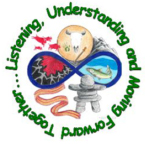
NOTE
Note: Consult with local Elders and Knowledge Keepers to learn more about sacred/significant sites in your local area.
Leanne Betasamosake Simpson- Nishnaabeg pedagogy, land based education, Indigenous Knowledge, resurgence
This interactive map allows users to view locations such as residential schools, as well as overlays such as trade routes and traditional territories.
Suzanne Keeptwo. Brush Education, 2021 . Book sumThe author sees the Land Acknowledgement as an opportunity for Indigenous peoples in Canada to communicate a message to non-Indigenous Canadians—a message founded upon Age Old Wisdom about how to sustain the Land we all want to call home. This is an essential narrative for truth sharing and knowledge acquisition.
Mary Wells speaks about Cree lessons that were inspired by nature.
Elder Wilton Goodstriker talks about traditional Kainai teachings for living in harmony with the environment and explains the current roles Elders take in consulting with outside developers.
Dora Unka relates her understanding of First Nations historical practice of living in harmony with the land.
Cree Elder Clifford Cardinal talks about the traditional Cree way of interacting with nature with intentionality and forethought.
Billy Joe Laboucan, Cree linguist and storyteller, talks about the traditional concept of reciprocity in relationship to the land.
Come walk in the footsteps of a trapper’s life at Métis Crossing.
A reflection on Jasper National Park and how his perspective changed after he explored and researched the history of Métis families and their experiences of colonization.
Transformation in reconciliation can occur when we seek to understand the historic and present-day relationships between Indigenous people and non-Indigenous people and their connection to land. Adrian shares his own reflections as he explored the land where many Métis families were displaced.
Cree Elder Berta Skye shares teachings on the importance of cedar.
Cree Elder Bertha Skya gives teachings on harvesting protocols and the important roles of medicines.
Cree Elder Bertha Skye shares teachings on medicines such as cedar, rose hip and pine.
This article explores a Winnipeg-based land-based learning initiative within public schools.
This article is about the implementation of a locally-developed course in Anzac, Alberta which focused on land-based learning.
Basic elements of Land-based Education with a focus on the Woodlands Cree are introduced along with four curriculum orientations that are connected to environment-related education.
Watch the videos. Begin the dialogue. Teach the curriculum. Water. The Sacred Relationship.
Learning from the Land video is a good exemplar of how Rocky View Schools collaborated with students, staff, parents and Elders to learn from the land and how to acknowledge the land. “Together we can learn and acknowledge together the teachings of Indigenous Peoples for future generations.”
This brief article speaks to the importance of understanding the the interconnectedness that Indigenous Peoples have with animals and the land.
A recent CBC Unreserved podcast highlights the influence that Indigenous architects are having, not only in Canada but internationally in designing buildings that are respectful of the landscape that invite all to feel welcome and to gather, honouring traditional Indigenous teachings. It also addresses the under representation of Indigenous peoples in this profession and mentions how we as educators, might encourage Indigenous students to consider this as a potential profession.
Actua is Canada’s largest STEM outreach organization that represents a growing network of programs . The paper is a summary of the seven roundtables and national forum held last fall on Indigenous land-based STEM education.
The Benefits of Land-Based Education and Programming
“ôtênaw is a film documenting the oral storytelling of dwayne donald, an educator from Edmonton alberta, canada. drawing from nêhiyawak philosophies, he speaks about the multilayered histories of indigenous peoples’ presence both within and around amiskwacîwâskahikan, or what has come to be known as the city of edmonton.”
How Indigenous teachings can change views of the night sky
Exploring Kainai plants and culture with locally made videos with Elders, classes and lessons.
Overview of CBE’s approach to learning about Land Acknowledgements
Students from the Werklund School of Education at the University of Calgary get out of the classroom and experience firsthand learning on the land.
To build respectful relationships, acknowledging the land is an important part of reconciliation. It honours the authentic history of North America, its original people and tells the story of the creation of this country that has historically been missing.
Ayaaq (Mary) Anowtalik and David Serkoak recount the Canadian government’s forced relocation of Inuit from their homeland in the interior of Nunavut in the 1950s and their long struggle for justice.
The first video in our Canada 150 series features Russell Fayant from the Gabriel Dumont Institute speaking about Métis cultural heritage and the legacy of the Road Allowance People – and why Canada 150 is not celebratory for everyone.
Forced to live on roadsides: the dark history of Métis road allowances. Jesse Thistle speaks to Unreserved to bring awareness of the history of Métis “road allowance people” as a story of resilience and resistance
Empowering Educators – Rupertsland Institute
Each theme shares information about Métis history, identity, and life in Alberta. Métis voices are authentically shared through the themes, woven together with academic research to best share our Métis story in Alberta.
RCTL YouTube Playlist: Explore Scrip – YouTube
Travel down a road about Canada’s history that has remained untold for far too long.
RCTL January 2021 PowerPoint Métis Scrip – RCTL January 2021 – Google Slides
The power of a tree: why birch and its bark are so important to Anishinaabe culture | Wiigwaasabak
Elementary Teachers’ Federation of Ontario. “The Indigenous land-based learning: A learning perspective resource was developed to demonstrate the journey of four ETFO writers whose perspectives of Indigenous land- based learning grew through a process of self-reflection, an interview with an Indigenous advisor (knowledge holder) and exploration and summary of relevant resources and tips for educators.”
Rocky View Schools. Elder Saa’kokoto shares a story about Napi and the origin of the Big Rock near Okotoks, Alberta.
Rocky View Schools. Writing-on-Stone follows a group of Rocky View School teachers as they journey into the history of the Áísínaiʼpi, a Blackfoot language word meaning “it is pictured.” Led by Blackfoot knowledge keeper, storyteller, educator and author, Saa’kokoto, the group learned about the significance of the land through stories of the Blackfoot people
Elder Saa’kokoto shares about the significance of the Sun Wheel in Nosehill Park, Calgary, AB.
Rocky View Schools. Saa’kokoto shares about ways of living & thriving on the Land & accepting the bounty of Na’a (Mother Earth) with gratitude.
Footnotes
| 1 | Littlebear, Leroy. Naturalizing Indigenous Knowledge. Canadian Council on Learning: 2009. Retrieved from http://neatoeco.com/iwise3/wp-content/uploads/2015/08/NaturalizingIndigenousKnowledge_LeroyLittlebear.pdf. |
| 2 | Indigenous Corporate Training Inc. “First Nation Relationship to the Land.” https://www.ictinc.ca/blog/first-nation-relationship-to-the-land |
| 3 | Makokis, Leona J., Marilyn V. Shirt, Sherri L. Chisan, Anne Y. Mageau, and Dianna M. Steinhauer. mâmawi-nehiyaw iyinikahiwewin. (Blue Quills First Nations College, 2010.) Retrieved from http://www.bluequills.ca/wp-content/uploads/2017/03/BQ_SSHRC_2010_final_report.pdf. |
| 4 | Métis Nation of Alberta. History of Métis Self-Government. Retrieved from http://www.albertametisgov.com/background/ |
| 5 | Ibid |
| 6 | Rupertsland Institute, Homeland History: Foundational Knowledge Themes. 2021. https://www.rupertsland.org/wp-content/uploads/2021/11/Homeland-History-Foundational-Knowledge-Themes-11.09.21-Rupertsland-Institute.pdf |
| 7 | Métis Nation of Alberta. History of Métis Self-Government. Retrieved from http://www.albertametisgov.com/background/ |
| 8 | 8 National Collaborating Centre for Aboriginal Health. 2009. Inuit Qaujimajatuqangit: The role of Indigenous knowledge in supporting wellness in Inuit communities in Nunavut. https://www.ccnsa-nccah.ca/docs/health/FS-InuitQaujimajatuqangitWellnessNunavut-Tagalik-EN.pdf |
| 9 | PPauktuutit Inuit Women of Canada. 2006. The Inuit Way: A Guide to Inuit Culture. http://apihtawikosisan.com/wp-content/uploads/2012/04/InuitWay_e.pdf. pp. 16, 43 |
| 10 | Inuit Tapiriit Kanatami. “About Canadian Inuit.” https://www.itk.ca/about-canadian-inuit/#nunangat |
| 11 | The Métis National Environment Committee. “Métis Traditional Environmental Knowledge.” https://www.metisnation.ca/wp-content/uploads/2011/05/Metis-Traditional-Knowledge.pdf |
| 12 | The Métis National Environment Committee. “Métis Traditional Environmental Knowledge.” https://www.metisnation.ca/wp-content/uploads/2011/05/Metis-Traditional-Knowledge.pdf |
| 13 | Chartier, C. (1993). Métis lands and resources. Sharing the Harvest: The Road to Self-Reliance, Report of the National Round Table on Aboriginal Economic Development and Resources (p. 43). Ottawa: Canada Communication Group Publishing. Retrieved from https://qspace.library.queensu.ca/bitstream/handle/1974/7732/Sharing_the_Harvest.pdf?sequence=1&isAllowed=y |
| 14 | Assembly of First Nations. Dismantling the Doctrine of Discovery. Retrieved from https://www.afn.ca/wp-content/uploads/2018/02/18-01-22-Dismantling-the-Doctrine-of-Discovery-EN.pdf |
| 15 | Gray, Christina and Daniel Rück. “Reclaiming Indigenous Place Names.” Yellowhead Institute, 2019. Retrieved from https://yellowheadinstitute.org/2019/10/08/reclaiming-indigenous-place-names/ |
| 16 | Suzanne Keeptwo. We All Go Back to the Land. The Who, Why, and How of Land Acknowledgements. Brush Education, 2021. p. 4 |




